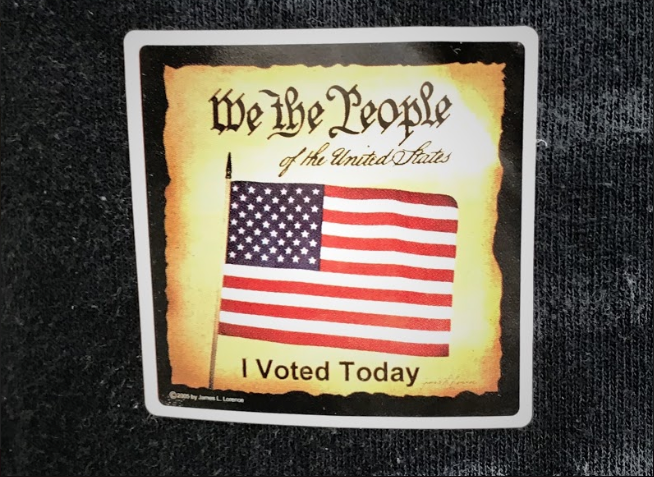UMW contributes to high voter turnout in midterm elections
4 min read
Chelsie Valencia
By KAITLYN MCCLUNG
Staff Writer
This election season, Fredericksburg saw a 5 percent increase in voter registration from 2017 due to a surge of 600 new University of Mary Washington students who registered to vote, according to The Free Lance-Star. The total number of registered voters totaled 18,043.
The National Study of Learning Voting and Engagement (NSLVE), conducted by Tufts University, assesses how many students are registered to vote and the rate at which they turn out. 1,021 higher education institutions across the United States participated in the study at the time of the last midterm election in 2014. The study included 9,632,630 students enrolled at 2 year, 4 year, private, and public institutions in 2014.
In the last midterm election, 72.1 percent of UMW students were registered to vote, and the final voting rate was 19.2 percent. The final voting rate at UMW was 0.1 percent higher than the national average of participating institutions across the country. Of the 19.2 percent that voted in 2014, 18.6 percent of students at University of Mary Washington voted via absentee ballot, and 80.4 percent voted in person on election day.
Statistics for the UMW voter turnout in the 2018 midterm election will not be available until a few months from now, when voting and enrollment are matched with other institutions for the 2018 midterm. Marina Castro-Meirelles, who graduated with a political science degree from UMW in 2018 and volunteered for NextGen, said “My personal observations lead me to think that UMW definitely saw greater turnout this November, and that more students voted absentee.” She has also conducted individual research on the state of civic engagement at UMW to argue for a Day on Democracy, a day when classes are canceled so students can vote. This led Castro-Meirelles to seek NSLVE’s report through a professor.
Students speculated that the potential increase in voter turnout was partially caused by NextGen’s push for voter registration on campus. “They kind of used peer pressure in the streets… They can’t force you, but they sure can peer pressure you into it. You just want them to stop harassing you,” said junior German and historic preservation double major Helen Sande.
NextGen America is a nonprofit and political action committee. NextGen Rising, NextGen’s youth voting program, sought to register and motivate 250,000 young people to vote in 2018. Since their founding, NextGen has registered one million people across the U.S.
Other students believed that the increase in voter registration was caused by social pressure and the heating of the political climate. Sean Ellis, a freshman, said he has seen his peers encouraging people to vote on social media like Instagram and Twitter.
“I feel like it’s becoming more mainstream because there were so many people all over campus making sure everyone is registered,” said Ellis.
Students are hopeful about the increasing awareness of young voters.
“I think it’s great that there are more people who are willing to go out and vote,” said freshman Erica Lopez. “I think there’s been more awareness, especially in this political climate. They want to make their opinions heard, so I think it’s really awesome that there’s better turnout.”

Freshman Gabriel Matteson believed efforts on campus, such as providing rides to and from polling places, helped to increase UMW voter turnout. He also attributed the rise of voter turnout to a more fervent desire to participate in politics in an increasingly tense political climate. To Matteson, voting is a privilege he wants to take advantage of, and the disenfranchisement of others inspired him to vote in the 2018 midterms.
“I have the right to vote, and some people don’t,” said Matteson. “I don’t want to fall under the mentality of the ‘Oh, it’s just one vote’ because if everybody does that, then that’s when the big differences come out.”
Dr. Stephen Farnsworth, a political science professor at UMW, weighed in on the rise in turnout for the midterm election. Compared to turnout rates in past midterm elections, voter turnout for 2018 was extremely high. There is usually a drop off between a presidential year and a midterm election.
“Younger people have been really motivated through a lot of get out the vote efforts in recent years, so their registration numbers and their interest in this election has really outpaced the way young voters felt about the election 4 years ago or 8 years ago,” Farnsworth said. “Because young people historically have not voted as much in midterm elections or elections generally than older voters, it creates powerful policy outcomes that don’t particularly help young people.”
Since young people do not vote at the rate that older people do, politicians focus more on the concerns of older voters. To illustrate this point, Farnsworth listed loans as an example. “There are a lot more protections for loans for real estate than for education… There are a lot of government subsidies for programs that benefit seniors who vote in greater numbers, and the consequence is higher costs for public education,” he said.
Dr. Farnsworth believes that there will be more intense investigations of the Trump presidency. “Expect the Democrats to be much more aggressive in following up on some of the things that the Mueller investigation has revealed about collusion between Trump campaign officials and the Russians.”
In terms of policy, Farnsworth expects there to be more attention on controversial issues involving environmental protections and the DREAMers.
“With Republicans in control of the Senate and Democrats in control of the House, that’s a recipe for even more gridlock in these next two years compared to the last two.”











